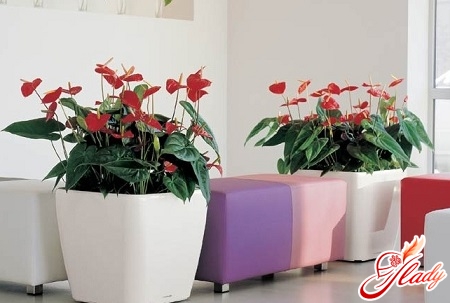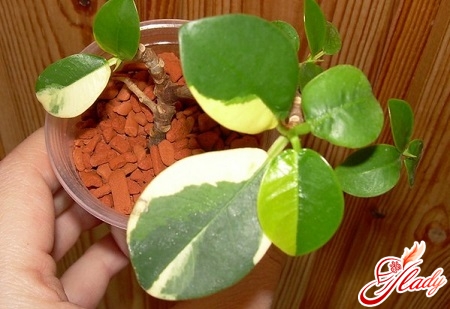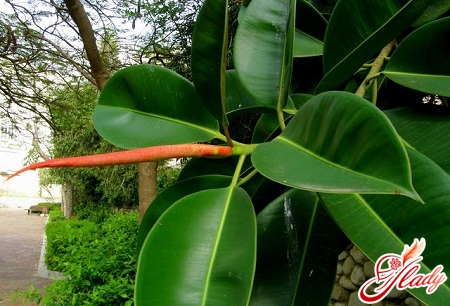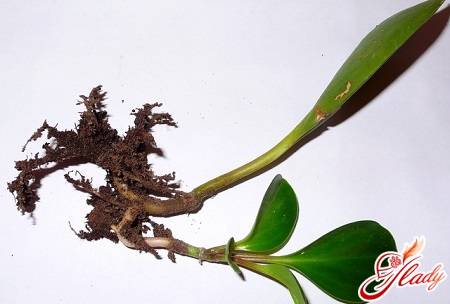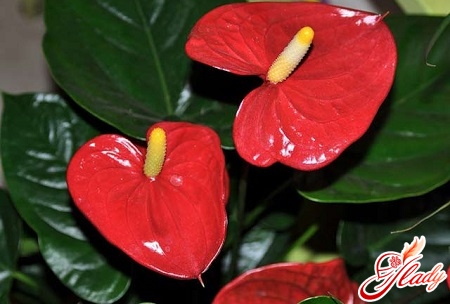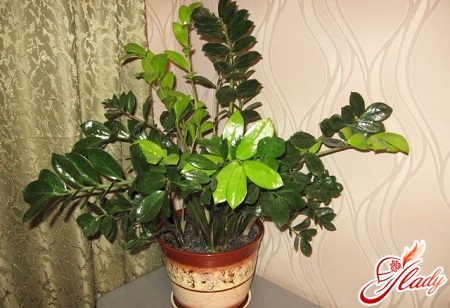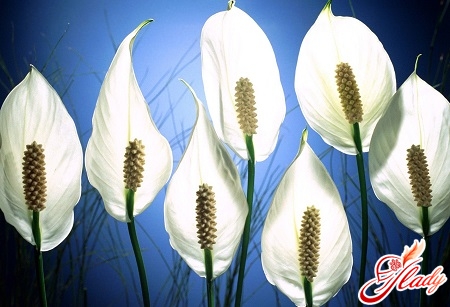 In nature spathiphyllum grows in the SouthAmerica, Polynesia and East Asia. This evergreen perennial plant lives in swampy areas, along lakes, rivers and streams. In people, spathiphyllum is called female happiness. It is believed that this room flower brings its owner luck and family peace. It is not recommended to give someone your personal spathiphyllum, because you give it to others and your well-being. But the flower spathiphyllum, specially bought as a gift, will help any woman to achieve what she most wants at the moment. For example, an unmarried woman will help to find her love, childless - to become pregnant and to give birth to a healthy child safely. It is also remarkable that with constant family scandals and lack of mutual understanding, spathiphyllum can not develop normally - he perishes, and not having time to please his mistress with effective flowering. Of course, only a calm environment in the house is not enough for the normal growth of the plant. Spathiphyllum, like any home flower, requires some attention. And in this article we will tell you what care the plant needs, how to properly transplant it and what is the reproduction of this indoor flower. But first, let's look at the kinds of spathiphyllum so that you can choose your flower.
In nature spathiphyllum grows in the SouthAmerica, Polynesia and East Asia. This evergreen perennial plant lives in swampy areas, along lakes, rivers and streams. In people, spathiphyllum is called female happiness. It is believed that this room flower brings its owner luck and family peace. It is not recommended to give someone your personal spathiphyllum, because you give it to others and your well-being. But the flower spathiphyllum, specially bought as a gift, will help any woman to achieve what she most wants at the moment. For example, an unmarried woman will help to find her love, childless - to become pregnant and to give birth to a healthy child safely. It is also remarkable that with constant family scandals and lack of mutual understanding, spathiphyllum can not develop normally - he perishes, and not having time to please his mistress with effective flowering. Of course, only a calm environment in the house is not enough for the normal growth of the plant. Spathiphyllum, like any home flower, requires some attention. And in this article we will tell you what care the plant needs, how to properly transplant it and what is the reproduction of this indoor flower. But first, let's look at the kinds of spathiphyllum so that you can choose your flower.
A variety of spathypylums
The species of this plant is diverse. They differ in size, the color of the bedspread (the so-called spathiphyllum flower) and the cob. All indoor varieties are hardy, long and abundant blossom.
- Wallis's Spathiphyllum
A flower with a short rhizome. The height reaches 30-40 centimeters. The leaves of this species are dark green, oblong, have an elegant form. The coverlet is white at the beginning of flowering and greenish - at the end. The plant is shade-tolerant and does not need any special care;
- Abundantly blooming spathiphyllum
Medium size (50-60 centimeters), it has oval-shaped leaves. Peduncles are large, the buds are formed right in the leaves, which provides abundant flowering almost all year round;
- Spathiphyllum charming
A large plant blooms not as abundant as twoas described above. The coverlet of this species of spathiphyllum has a greenish-white hue and resembles a flag. Flowering lasts from April to June;
- Spathiphyllum spoon-like
Large indoor flower growing to onemeter in height. The leaves of this variety have an oblong shape, the texture is glossy, and wavy at the edges. The coverlet is white and has the shape of a spoon;
- Spathiphyllum cannon
Also a large plant whose leaves look likeleaves canna. The cob is yellow, the coverlet is white-green, with a sharp aroma. The room spathiphyllum has one more name - a white sail. It appeared due to the shape of its inflorescences. Cut flowers of any kind of spathiphyllum can keep their freshness about a month, so they often use florists to create holiday bouquets. 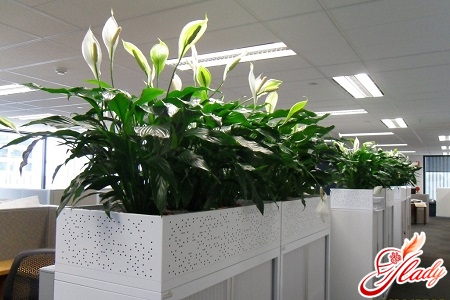
Features of care
All species of this plant are not toofastidious, so caring for them will not bring you any special problems. Spathiphyllum likes shaded places - bright sunlight is contraindicated to him. However, this does not mean that the flower should be kept in the dark at all times. If you notice that the leaves of the plant are stretched out and have acquired a dark color - it lacks lighting. Spoil your spathiphyllum with sun baths or arrange artificial light with fluorescent lamps. By the way, with artificial lighting, the flower grows faster and more often throws out buds. Cold air and draft are destructive for this tropical handsome man. Therefore, in winter, pay attention to the organization in the room of the desired temperature regime. 23-25 degrees of heat - these are the optimal conditions for growing spathiphyllum. Top dressing is introduced during the period of growth and flowering, once a week. Before using the fertilizer, carefully study the instructions and act strictly on it. If the leaves of the plant sagged and wilted - it lacks moisture. Remember, the root system of the flower should always be moist. Therefore, and water spathiphyllum should be abundant - as the drying of the upper soil layer. Once a week, arrange a flower water treatment in the form of a shower. Wipe the leaves with a clean cloth to prevent dust accumulation. If after water procedures in the pallet there is water, do not rush to drain it, leave it for several hours. The humid environment is necessary for the plant in winter and in summer. Therefore, with the onset of cold weather, it is not necessary to radically change its content.
Reproduction and transplantation
Reproduction spathiphyllum occurs either by divisionbush (during transplantation), or apical cuttings. Before you start breeding (divide the adult plant), carefully untangle the roots, trying not to damage them. Then seed the spathiphyllum on newer pots of a smaller size. To root the cuttings, it is necessary to create a greenhouse effect for them. Put the procession in the ground, cover it with a glass container. When spathiphyllum leaves young leaves, you can safely remove the greenhouse. Watering during rooting produce in only a pallet. Care for a young plant is no different from the content of an adult flower. In order to transplant spathiphyllum, it is necessary to prepare the soil. Mix in equal parts humus, leaf and sod land, peat and sand. In order for the substrate to have the necessary air permeability, add to it small brick chips and pieces of charcoal. Before transplanting spathiphyllum, place drainage on the bottom of the pot, which can be used as expanded clay. Transplanting spathiphyllum is necessary every year with the onset of spring. The size of the pot is chosen based on the size of the plant itself. Too much capacity should not be taken - this will slow down the growth of the flower in the future. After the transplant is made, put the spathiphyllum in a warm place and sprinkle it daily. While the plant does not take root, do not water it too much. Rooting lasts about a week, so at this time, cut irrigation twice. Feeding at this time is also not needed. When spathiphyllum takes root, care returns to the previous regime. 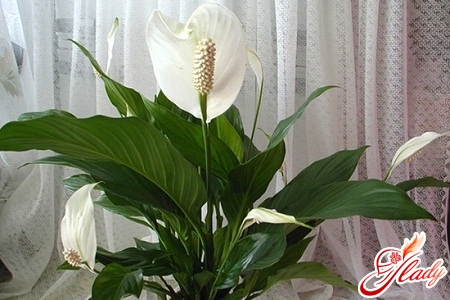
What difficulties can arise when growing spathiphyllum?
Spathiphyllum is considered an unpretentious plant. However, he is not immune from some problems. Let's consider what troubles can expect owners of this plant during cultivation, and what care is needed for him to recover.
- The tips of the leaves turn yellow and dry.
This problem occurs because of insufficientof air humidity. In the conditions of urban apartments this is inevitable, even with frequent spraying. To increase the humidity is simple: pour pebbles (or other pebbles) into a small tray, moisten it, put a spathiphyllum on top. This method is good for winter flower maintenance. It is in winter that the air in the room is overdone due to heating devices;
- Brown spots on the leaves
The excessive soil moisture orstagnation of water in the pan. Well dry spathiphyllum (do not water it for 3-4 days). Spray the leaves do not stop. Then podpushite earth in the pot, and the next day, abundantly water the plant;
- The edges of the leaves turn black
This indicates a lack of mineral substances insoil - you need to feed spathiphyllum. Use nitrogen-containing and phosphorus-containing fertilizers. Top dressing should be started as soon as possible, otherwise the leaves will completely blacken and fall off.
- Pests
Spathiphyllum is prone to attacks of thrips, mealychervets and spider mites. If the insects have not yet completely hit the plant, the usual soap solution, which needs to be washed by the leaves, will help. In advanced cases, special chemicals are used, sold in flower shops. Sometimes an unplanned transplant is required. So we learned about the spathiphyllum, the flowering of which will not leave a single person indifferent. Love the plant and, if possible, provide it with the necessary care. The rest of the flower will do it yourself - bring real woman's happiness to your house!




